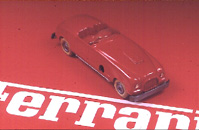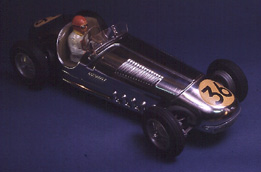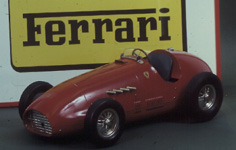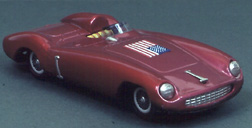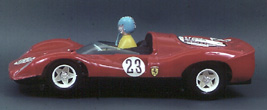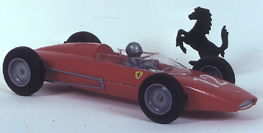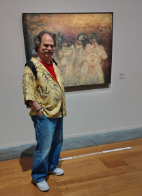06 - Pitcheetoy
Jouets anciens - Antique Toys
Depuis 1970 - Since 1970
Créateur du Salon TOYMANIA
Creator of the PARIS antique toy show
TOYMANIA



DIY
Articles Toys & Dolls
FERRARI MINIATURES:
MYTHE ET CURIOSITE
Texte et photos: MICK DUPRAT
Les automobiles de marque Ferrari sont à l'origine d'un innombrable parc de miniatures. Il s'en est produit des quantités considérables. Toutefois, quelques-unes se démarquent des autres productions par une approche non-conventionnelle des choses.
Ces jouets sont parfois insolites par leur forme approximative ou surréaliste. C'est avec ces Ferrari-là que nous allons parcourir, aujourd'hui, le passionnant monde lilliputien. Dans la réalité, tout commença chez Ferrari avec le type 166 MM. Cette auto doit ses deux initiales à l'exaltante course des Mille Milles qui se déroulait en Italie, pour l'avoir inscrite à son palmarès, trois fois de suite, en 1948, 1949 et 1950. Cette Ferrari, première mouture, doit aux marques de jouets Solido et Idéal son existence dans l'univers de la miniature. La barquette Ferrari a probablement séduit les responsables de la marque française Solido le jour où les pilotes Luigi Chinetti et Selsdon remportèrent à leur volant, en 1948, la course des 12 Heures de Paris.
Six ans plus tard, préférant un simple 4 cylindres au fabuleux 12 cylindres qui fera plus tard sa renommée, Ferrari décroche avec ce nouveau moteur disposé dans les type 750, le titre de Champion du monde de la catégorie voitures de sport. Avec ses 1re et 2e places sur l'autodrome de Monza, les Ferrari victorieuses donneront naissance à une toute petite série qui portera le nom de Monza, l'autodrome où elles se mirent en valeur pour la première fois.
Aux Etats-Unis, ce sont les pilotes Phill Hill et Carroll Shelby qui se distingueront au volant d'une Monza et ce n'est pas parce que les Japonais ne sont pas grands physiquement qu'il faut en déduire que leur mémoire est courte. Dix ans plus tard, ils se souviendront des exploits de ces deux pilotes américains et la marque japonaise Bandaï éditera une exceptionnelle Monza en tôle décorée du célèbre drapeau américain "stars and stripes" décorant le capot.
Au début des années cinquante, Ferrari va faire son entrée dans le cercle des constructeurs de bolides destinés aux grands prix. C'est la plus longue et la plus importante carrière qu'un constructeur ait consacré aux monoplaces puisque de nos jours encore, Ferrari continue imperturbable à aligner aux meilleures places ses montures rouges frappées du cheval cabré, logotype de la Scuderia créé par Enzo Ferrari lui-même. Mais si le rouge, autrefois couleur nationale des voitures italiennes de grands prix, est associé à Ferrari pour la postérité, quelques-unes ont été décorées d'une couleur nationale d'un autre pays. Cela surprend un peu, mais ce choix a été réalisé, entre autres fabricants de jouets, par Lima et Braglia, avec une monoplace jaune pour le premier cité et une verte produite parallèlement à une rouge pour le second. Rappelons que la couleur jaune fut celle réservée à l'usage des autos de course de nationalité belge et la verte à celles de Grande-Bretagne.
Quant à la marque italienne de jouets Ingap, elle a choisi le chrome qui s'apparente pourtant plus à la couleur argent des bolides concurrents allemands de l'époque, Mercedes en formule 1 et Porsche en formule 2! Le réalisme est une notion qui semble avoir manqué à quelques fabricants de jouets, ce qui choque assez souvent les collectionneurs pour qui dans l'ensemble une Ferrari n'est pas tout à fait une Ferrari quand elle n'est pas de couleur rouge.
La marque d'apéritif italien Toschi demanda un jour au spécialiste Marchesini un conditionnement particulier pour ses produits alcoolisés. Le spécialiste en question utilisera les lignes de la Ferrari type 500 de formule 2 au volant de laquelle tous les grands champions des années cinquante - Villoresi, Ascari et Farina en tête - décrochèrent les premières places de grands prix dans le monde entier, pour réaliser une bouteille qui, une fois vidée de son contenu, devenait un jouet des plus attractifs pour les petits enfants mais aussi les parents!
En 1953, la marque souveraine à l'échelle du 1/43e, Dinky-Toys, se manifeste en ajoutant à son catalogue une monplace de type identique à la Ferrari Apéritif Toschi, peinte toutefois en bleu, avec le "nez" jaune, qui sont les couleurs nationales pour les écuries provenant d'Argentine. Cette Ferrari sera diffusée, plus tard, en rouge avec des numéros de start tellement variés et nombreux qu'aujourd'hui, des collectionneurs de Dinky-Toys et de Ferrari, en particulier - et de 1/43e en général - en ont fait un thème dans leur thème, procurant à cette Ferrari, pourtant notoirement diffusée, une exceptionnelle position qui la marginalise.
Tandis que la marque allemande J.N.F. marque le passage du moteur de l'avant à l'arrière sur une monoplace Ferrari avec sa "Struxi", reproduisant la Dino 156 F1 de 1961, apparaît une curiosité - encore une - sous la forme d'une Superamerica... compétition. Une curiosité qui repose sur le fait que son concepteur Pininfarina n'a jamais prévu cette Ferrari pour la course mais bel et bien pour l'apparât! C'est à Bandaï que l'on doit cette auto-jouet peu conformiste et comme cette production inattendue pouvait en cacher d'autres, la même marque japonaise commercialisa en 1958, un cabriolet Superamerica d'où émerge une conducteur à la tête démesurée; puis en 1960, une autre Superamerica au hard-top très spécial; enfin, en 1964, une 275 GTB en version... "Police"! Peut-être son concepteur avait-il puisé cette idée à la vue de ces autres rapides GT attribuées à notre police des autoroutes que sont les Porsche?
Cette fantaisie en a rencontré une autre sous la forme de la Ferrari 330 P4. Son concepteur italien Elegi n'a probablement jamais vu un pilote au volant d'une Ferrari, puisque le préposé au pilotage de cette P4 n'est ni couché, ni allongé mais carrément assis à l'équerre! Cette Ferrari, pourtant pas trop mal réussie esthétiquement, devient franchement bizarre par ce manque d'attention au sujet de la position de son pilote.
Vers la fin des années soixante, Ingap produira à son tour une pièce d'exception sous la forme d'une F1 type 158. Ce jouet se démarque des autres Ferrari par le fait qu'il sera à la fois la dernière Ferrari et le dernier jouet produit par cette marque, avant qu'elle ne ferme définitivement ses portes. Son niveau de fabrication est le reflet du climat qui régnait alors. La matière plastique fait aussi "pauvre" que le compte en banque d'Ingap et que le niveau d'entente qui régnait dans le même temps entre Enzo Ferrari, ses pilotes, ses ingéneurs et ses mécaniciens.
Les tifosi durent attendre la décennie 70 pour voir enfin la bonne humeur revenir conquérir le clan Ferrari. Entre 1966 et 1968, la type 312 connaît un succès extraordinaire en course. Cette Ferrari sera la première à employer le célèbre aileron stabilisateur positionné sur l'arrière qui se généralisera ensuite chez tous les autres constructeurs concurrents. Raison nécessaire et suffisante pour que le constructeur de miniatures allemand Schuco planche sur cette monoplace spécifique. Il en créera deux versions: une bien connue, celle qui n'est pas démontable entièrement et une version peu connue qui, elle, est entièrement démontable.
Ferrari ayant renoué avec le succès, grâce au pilote autrichien Niki Lauda, devenu champion du monde en 1975, puis en 1977, l'apéritif Toschi renoue quant à lui avec la production d'un conditionnement. Cette fois, Toschi fait appel à Polistil pour lui fournir une série de Ferrari 312 T dans lesquelles coulera, pour fêter les bons moments, l'apéritif maison. Si la première de ces bouteilles est bien connue, cette de Polistil l'est beaucoup moins des Ferraristes comme des collectionneurs d'autos miniatures. A ce titre, la Ferrari 312 T2 Toschi-Polistil rentre dans le club très fermé des Ferrari particulières de petite échelle.
L'ultime Ferrari d'exception de notre propos est en plastique. De surcroît, sa couleur est bleue. Même dans son pays d'origine, l'Espagne, cette Ferrari est quasiment inconnue. Il s'agit d'une barquette 330 P3 à l'intérieur de laquelle pilote et co-pilote de rallye, notes à la main, s'affairent pour obtenir le meilleur temps. La curiosité, due à la marque espagnole Vansa, provient à la fois de la couleur bleue employée et de ce type de Ferrari qui n'a jamais couru en rallye!
Sur le thème Ferrari, comme ailleurs, la rigueur n'a pas toujours été au premier plan des préoccupations des fabricants de jouets qui se sont penchés sur leurs reproductions à la dimension des enfants. Il est vrai que ces fantaisies procurent un regain d'intérêt pour les petites Ferrari, intérêt venant s'ajouter aux pièces, certes conçues avec précision et réalisme, mais restant rares dans l'univers merveilleux de l'automobile miniature! A marque prestigieuse, miniatures d'exception...
Mick DUPRAT
Ces jouets sont parfois insolites par leur forme approximative ou surréaliste. C'est avec ces Ferrari-là que nous allons parcourir, aujourd'hui, le passionnant monde lilliputien. Dans la réalité, tout commença chez Ferrari avec le type 166 MM. Cette auto doit ses deux initiales à l'exaltante course des Mille Milles qui se déroulait en Italie, pour l'avoir inscrite à son palmarès, trois fois de suite, en 1948, 1949 et 1950. Cette Ferrari, première mouture, doit aux marques de jouets Solido et Idéal son existence dans l'univers de la miniature. La barquette Ferrari a probablement séduit les responsables de la marque française Solido le jour où les pilotes Luigi Chinetti et Selsdon remportèrent à leur volant, en 1948, la course des 12 Heures de Paris.
Six ans plus tard, préférant un simple 4 cylindres au fabuleux 12 cylindres qui fera plus tard sa renommée, Ferrari décroche avec ce nouveau moteur disposé dans les type 750, le titre de Champion du monde de la catégorie voitures de sport. Avec ses 1re et 2e places sur l'autodrome de Monza, les Ferrari victorieuses donneront naissance à une toute petite série qui portera le nom de Monza, l'autodrome où elles se mirent en valeur pour la première fois.
Aux Etats-Unis, ce sont les pilotes Phill Hill et Carroll Shelby qui se distingueront au volant d'une Monza et ce n'est pas parce que les Japonais ne sont pas grands physiquement qu'il faut en déduire que leur mémoire est courte. Dix ans plus tard, ils se souviendront des exploits de ces deux pilotes américains et la marque japonaise Bandaï éditera une exceptionnelle Monza en tôle décorée du célèbre drapeau américain "stars and stripes" décorant le capot.
Au début des années cinquante, Ferrari va faire son entrée dans le cercle des constructeurs de bolides destinés aux grands prix. C'est la plus longue et la plus importante carrière qu'un constructeur ait consacré aux monoplaces puisque de nos jours encore, Ferrari continue imperturbable à aligner aux meilleures places ses montures rouges frappées du cheval cabré, logotype de la Scuderia créé par Enzo Ferrari lui-même. Mais si le rouge, autrefois couleur nationale des voitures italiennes de grands prix, est associé à Ferrari pour la postérité, quelques-unes ont été décorées d'une couleur nationale d'un autre pays. Cela surprend un peu, mais ce choix a été réalisé, entre autres fabricants de jouets, par Lima et Braglia, avec une monoplace jaune pour le premier cité et une verte produite parallèlement à une rouge pour le second. Rappelons que la couleur jaune fut celle réservée à l'usage des autos de course de nationalité belge et la verte à celles de Grande-Bretagne.
Quant à la marque italienne de jouets Ingap, elle a choisi le chrome qui s'apparente pourtant plus à la couleur argent des bolides concurrents allemands de l'époque, Mercedes en formule 1 et Porsche en formule 2! Le réalisme est une notion qui semble avoir manqué à quelques fabricants de jouets, ce qui choque assez souvent les collectionneurs pour qui dans l'ensemble une Ferrari n'est pas tout à fait une Ferrari quand elle n'est pas de couleur rouge.
La marque d'apéritif italien Toschi demanda un jour au spécialiste Marchesini un conditionnement particulier pour ses produits alcoolisés. Le spécialiste en question utilisera les lignes de la Ferrari type 500 de formule 2 au volant de laquelle tous les grands champions des années cinquante - Villoresi, Ascari et Farina en tête - décrochèrent les premières places de grands prix dans le monde entier, pour réaliser une bouteille qui, une fois vidée de son contenu, devenait un jouet des plus attractifs pour les petits enfants mais aussi les parents!
En 1953, la marque souveraine à l'échelle du 1/43e, Dinky-Toys, se manifeste en ajoutant à son catalogue une monplace de type identique à la Ferrari Apéritif Toschi, peinte toutefois en bleu, avec le "nez" jaune, qui sont les couleurs nationales pour les écuries provenant d'Argentine. Cette Ferrari sera diffusée, plus tard, en rouge avec des numéros de start tellement variés et nombreux qu'aujourd'hui, des collectionneurs de Dinky-Toys et de Ferrari, en particulier - et de 1/43e en général - en ont fait un thème dans leur thème, procurant à cette Ferrari, pourtant notoirement diffusée, une exceptionnelle position qui la marginalise.
Tandis que la marque allemande J.N.F. marque le passage du moteur de l'avant à l'arrière sur une monoplace Ferrari avec sa "Struxi", reproduisant la Dino 156 F1 de 1961, apparaît une curiosité - encore une - sous la forme d'une Superamerica... compétition. Une curiosité qui repose sur le fait que son concepteur Pininfarina n'a jamais prévu cette Ferrari pour la course mais bel et bien pour l'apparât! C'est à Bandaï que l'on doit cette auto-jouet peu conformiste et comme cette production inattendue pouvait en cacher d'autres, la même marque japonaise commercialisa en 1958, un cabriolet Superamerica d'où émerge une conducteur à la tête démesurée; puis en 1960, une autre Superamerica au hard-top très spécial; enfin, en 1964, une 275 GTB en version... "Police"! Peut-être son concepteur avait-il puisé cette idée à la vue de ces autres rapides GT attribuées à notre police des autoroutes que sont les Porsche?
Cette fantaisie en a rencontré une autre sous la forme de la Ferrari 330 P4. Son concepteur italien Elegi n'a probablement jamais vu un pilote au volant d'une Ferrari, puisque le préposé au pilotage de cette P4 n'est ni couché, ni allongé mais carrément assis à l'équerre! Cette Ferrari, pourtant pas trop mal réussie esthétiquement, devient franchement bizarre par ce manque d'attention au sujet de la position de son pilote.
Vers la fin des années soixante, Ingap produira à son tour une pièce d'exception sous la forme d'une F1 type 158. Ce jouet se démarque des autres Ferrari par le fait qu'il sera à la fois la dernière Ferrari et le dernier jouet produit par cette marque, avant qu'elle ne ferme définitivement ses portes. Son niveau de fabrication est le reflet du climat qui régnait alors. La matière plastique fait aussi "pauvre" que le compte en banque d'Ingap et que le niveau d'entente qui régnait dans le même temps entre Enzo Ferrari, ses pilotes, ses ingéneurs et ses mécaniciens.
Les tifosi durent attendre la décennie 70 pour voir enfin la bonne humeur revenir conquérir le clan Ferrari. Entre 1966 et 1968, la type 312 connaît un succès extraordinaire en course. Cette Ferrari sera la première à employer le célèbre aileron stabilisateur positionné sur l'arrière qui se généralisera ensuite chez tous les autres constructeurs concurrents. Raison nécessaire et suffisante pour que le constructeur de miniatures allemand Schuco planche sur cette monoplace spécifique. Il en créera deux versions: une bien connue, celle qui n'est pas démontable entièrement et une version peu connue qui, elle, est entièrement démontable.
Ferrari ayant renoué avec le succès, grâce au pilote autrichien Niki Lauda, devenu champion du monde en 1975, puis en 1977, l'apéritif Toschi renoue quant à lui avec la production d'un conditionnement. Cette fois, Toschi fait appel à Polistil pour lui fournir une série de Ferrari 312 T dans lesquelles coulera, pour fêter les bons moments, l'apéritif maison. Si la première de ces bouteilles est bien connue, cette de Polistil l'est beaucoup moins des Ferraristes comme des collectionneurs d'autos miniatures. A ce titre, la Ferrari 312 T2 Toschi-Polistil rentre dans le club très fermé des Ferrari particulières de petite échelle.
L'ultime Ferrari d'exception de notre propos est en plastique. De surcroît, sa couleur est bleue. Même dans son pays d'origine, l'Espagne, cette Ferrari est quasiment inconnue. Il s'agit d'une barquette 330 P3 à l'intérieur de laquelle pilote et co-pilote de rallye, notes à la main, s'affairent pour obtenir le meilleur temps. La curiosité, due à la marque espagnole Vansa, provient à la fois de la couleur bleue employée et de ce type de Ferrari qui n'a jamais couru en rallye!
Sur le thème Ferrari, comme ailleurs, la rigueur n'a pas toujours été au premier plan des préoccupations des fabricants de jouets qui se sont penchés sur leurs reproductions à la dimension des enfants. Il est vrai que ces fantaisies procurent un regain d'intérêt pour les petites Ferrari, intérêt venant s'ajouter aux pièces, certes conçues avec précision et réalisme, mais restant rares dans l'univers merveilleux de l'automobile miniature! A marque prestigieuse, miniatures d'exception...
Mick DUPRAT
------------------------------------------------------------------------------------
US/ENG VERSION
SMALL SCALE FERRARI MYTH AND CURIOSITY
Texte and photos: MICK DUPRAT
Ferrari Automobiles are behind an innumerable park of miniatures. It has produced considerable quantities. Nevertheless, some plagiarize the other productions by an approach non-conventional of things.
These toys are sometime peculiar by their surrealist or approximate form. It is with these kind Ferrari that we are going to cover, to-day, the fascinating world of miniaturist. In the reality, whole began at Ferrari with the type 166MM. This car has its two initials to the fascinating race of the "Mille Milles" that unfolded in Italy, to have registred it to its record book, three time, in 1948, 1949 and 1950. This Ferrari, first made, has the trademark Solido and Ideal its existence in the universe of the miniature. The "barquette" Ferrari has probably seduced superintendents of the French toymaker Solido the day where the pilots Luigi Chinetti and Selsdon achieved on their driving-wheel, in 1948, the race of 12 Hours of Paris.
Six years later, preferring a simple 4 cylinders to the fabulous 12 cylinders that will make later its reputation, Ferrari unhooks the title World Champion of the sport category with this new engine in the models 750. With its first and second place on the Ring racing track of Monza, victorious Ferrari will give bith to a small series that will have the name of Monza, the racing track where they gaze in value for the time first.
In the United States, these pilots Phill Hill and Caroll Shelby that will distinguish themself at their driving wheel in Monza, this is not because Japanese are not so tall physically that they are short minded. Ten years later, thez will remember the records of these two American pilots and the Japanese maker Bandaï will built an exceptionnel Monza with a decorated griddle of the famous American flag "Stars and stripes" decorating the hood.
In the beginning of 50's, Ferrari is going to make its entry in the circle of racing car constructor destined for the "Grand Prix". It is the longest and the most important career thet a constructor has devoted to one-seaters since as seven in our days he is still there, Ferrari continue to align to the best places its knocked red mounts the horse, a logotype of the Scuderia created by Enzo Ferrari himself. But if the red, formerly national color of Italian cars of "Grands Prix", is associated to Ferrari for the posterity, some have been decorated with national color of some other countries. That surprises a bit, but this choice has been realized, among others manufacturers ot toys, by Lima and Braglia, with a yellow one-seater for the first city and a green and red aswell for the second. Remind that the yellow color was the one reserved for the race cars of Belgium and green for those of Great Britain.
As for the Italian toy marker Ingap, it has chosen the chromium that is apparent nevertheless more the silver color of the German racing car of that period, Mercedes in F1 (formula 1) and Porsche in F2 (formula 2)! The realism is a notion that seems not to have some toys manufacturers, what shocks often collectors for that, as for them a Ferrari is not entirely a ferrari if it is not in red color.
The Italian appetizer maker Toschi asked some day to the specialist Marchesini a special container for its alcoholic products. The specialist in question will use lines of the Ferrari model 500 of F2 at the driving wheel of which all the great champions of 50's - Villoresi, Ascari and Farina - unhooked the first places at the "Grands Prix" in the whole world, to realize a bottle that once emptied of its content became the most attractiv toy for the small children but also to the parents!
In 1953, the top maker of the scale 1/43: Dinky-Toys, demonstrates by adding to its catalogue a monoplace (one seater) identical model of the Ferrari Appetizer Toschi, painted nevertheless in blue withe "the nose" yellow, that are national colors for the racing team coming from Argentina. This Ferrari will be distributed, later, in red with start numbers so varied and numerous that to-day, collectors of Dinky-Toys and Ferrari, especially 1/43 in general-have made some a theme in their theme, obtaining for these ferrai, nevertheless notoriously distributed, an exceptional position that itput it a bit on the side. While the German maker J.N.F. marks the passage of the front engine to rear on an one-seater Ferrari with its "Struxi", reproducing a Dino 156 F1 1961, appears a curiosity - again another one - the shape of a Superamerica competition. A curiosity that in fact its designer Pininfarina has never anticipated this Ferrari for the race but beautiful and well made for the "apparat"! It is Bandaï that built this car none conformist and as this unexpected production could hide some others, this even Japanese maker commercialized in 1958, a cabriolet Superamerica hard-top very special; finally, in 1964, a 275GTB in version... "Police"! Can-be its designer had-it drawn this idea to the view of these rapid GT attributed to our police of turnpikes that are Porsche?
This fantasy has met some other under the figure of a Ferrari 330P4. Its Italian creator Elegi has probably never seen a pilot at the driving wheel of a Ferrari, since the official piloting position of this P4 is neither laid down, nor lengthened but bluntly sat to the square! This Ferrari, nevertheless too badly succeded esthetically, becomes frankly bizarre by this lack of attention about the position of pilot.
At the end of the sixty's, Ingap will produce under the shape of a typical F1 model 158. This toy so different from the other Ferrari by the fact that it will beboth the last Ferrari and the last toy produced by this maker, before it closes definitively its doors. The plastic is as poor as the bank account of Ingap and also the same kind of level of friendship between Enzo Ferrari, its pilots, its designers and its mechanics.
The "tifosi" had to wait the decade 70 to see finally the good mood to return to conquer the Ferrari clan. Between 1966 and 1968, the model 312 knows an extraordinary success in the races. This Ferrari will be the first to use the famous stabilizing wing at the rear that will generalize then at all the other constructive competitions. Sufficient and necessary reason in order that the German miniature constructor Schuco board on this specific one-seater. It will create some two versions: a well known, that is none come apart and a unknown version that entirely comes part.
Ferrari having renewed with the success, thanks to Austrian pilot Niki Lauda, become World champion in 1975, then in 1977, the appetizer Toschi renews tradition with the production of a container. This time, Toschi agree with Polistil to provide him with a series of Ferrari 312P in which will flow, to celebrate the good moments, the house appetizer. If the first of these bottles is well known, the one from Polistil is a lot less Ferraristes for a collectors of miniature cars. To his title, Ferrari 312T2 Toschi-Polistil is part of the very closed club of particular small scale Ferrari.
The ultimate Ferrari of exception of our purpose is in plastic. Addittion, its color is blue. Even in its country of origin, Spain, this Ferrari is very strange. It concerns a "barquette" 330P3 inside which, pilots and rally co-pilot, road-book with his hands, busy to obtain a better time. The curiosity, due to the Spanish maker Vansa, comes both from the blue color used and this type of Ferrari that has never ran in rally!
On the Ferrari theme, as elsewhere, the rigor has not always been in the forefront preoccupations of toy manufacturers that have learned on their reproductions to the dimension of children. Il is true that these fantasies obtain a renewal of interest for the small Ferrari, interest coming to be added to these pieces, indeed conceived with precision and realism, but rare remainder in the wonderful universe of the miniature automobile! To a prestigious maker, miniatures of exception...
Mick DUPRAT
These toys are sometime peculiar by their surrealist or approximate form. It is with these kind Ferrari that we are going to cover, to-day, the fascinating world of miniaturist. In the reality, whole began at Ferrari with the type 166MM. This car has its two initials to the fascinating race of the "Mille Milles" that unfolded in Italy, to have registred it to its record book, three time, in 1948, 1949 and 1950. This Ferrari, first made, has the trademark Solido and Ideal its existence in the universe of the miniature. The "barquette" Ferrari has probably seduced superintendents of the French toymaker Solido the day where the pilots Luigi Chinetti and Selsdon achieved on their driving-wheel, in 1948, the race of 12 Hours of Paris.
Six years later, preferring a simple 4 cylinders to the fabulous 12 cylinders that will make later its reputation, Ferrari unhooks the title World Champion of the sport category with this new engine in the models 750. With its first and second place on the Ring racing track of Monza, victorious Ferrari will give bith to a small series that will have the name of Monza, the racing track where they gaze in value for the time first.
In the United States, these pilots Phill Hill and Caroll Shelby that will distinguish themself at their driving wheel in Monza, this is not because Japanese are not so tall physically that they are short minded. Ten years later, thez will remember the records of these two American pilots and the Japanese maker Bandaï will built an exceptionnel Monza with a decorated griddle of the famous American flag "Stars and stripes" decorating the hood.
In the beginning of 50's, Ferrari is going to make its entry in the circle of racing car constructor destined for the "Grand Prix". It is the longest and the most important career thet a constructor has devoted to one-seaters since as seven in our days he is still there, Ferrari continue to align to the best places its knocked red mounts the horse, a logotype of the Scuderia created by Enzo Ferrari himself. But if the red, formerly national color of Italian cars of "Grands Prix", is associated to Ferrari for the posterity, some have been decorated with national color of some other countries. That surprises a bit, but this choice has been realized, among others manufacturers ot toys, by Lima and Braglia, with a yellow one-seater for the first city and a green and red aswell for the second. Remind that the yellow color was the one reserved for the race cars of Belgium and green for those of Great Britain.
As for the Italian toy marker Ingap, it has chosen the chromium that is apparent nevertheless more the silver color of the German racing car of that period, Mercedes in F1 (formula 1) and Porsche in F2 (formula 2)! The realism is a notion that seems not to have some toys manufacturers, what shocks often collectors for that, as for them a Ferrari is not entirely a ferrari if it is not in red color.
The Italian appetizer maker Toschi asked some day to the specialist Marchesini a special container for its alcoholic products. The specialist in question will use lines of the Ferrari model 500 of F2 at the driving wheel of which all the great champions of 50's - Villoresi, Ascari and Farina - unhooked the first places at the "Grands Prix" in the whole world, to realize a bottle that once emptied of its content became the most attractiv toy for the small children but also to the parents!
In 1953, the top maker of the scale 1/43: Dinky-Toys, demonstrates by adding to its catalogue a monoplace (one seater) identical model of the Ferrari Appetizer Toschi, painted nevertheless in blue withe "the nose" yellow, that are national colors for the racing team coming from Argentina. This Ferrari will be distributed, later, in red with start numbers so varied and numerous that to-day, collectors of Dinky-Toys and Ferrari, especially 1/43 in general-have made some a theme in their theme, obtaining for these ferrai, nevertheless notoriously distributed, an exceptional position that itput it a bit on the side. While the German maker J.N.F. marks the passage of the front engine to rear on an one-seater Ferrari with its "Struxi", reproducing a Dino 156 F1 1961, appears a curiosity - again another one - the shape of a Superamerica competition. A curiosity that in fact its designer Pininfarina has never anticipated this Ferrari for the race but beautiful and well made for the "apparat"! It is Bandaï that built this car none conformist and as this unexpected production could hide some others, this even Japanese maker commercialized in 1958, a cabriolet Superamerica hard-top very special; finally, in 1964, a 275GTB in version... "Police"! Can-be its designer had-it drawn this idea to the view of these rapid GT attributed to our police of turnpikes that are Porsche?
This fantasy has met some other under the figure of a Ferrari 330P4. Its Italian creator Elegi has probably never seen a pilot at the driving wheel of a Ferrari, since the official piloting position of this P4 is neither laid down, nor lengthened but bluntly sat to the square! This Ferrari, nevertheless too badly succeded esthetically, becomes frankly bizarre by this lack of attention about the position of pilot.
At the end of the sixty's, Ingap will produce under the shape of a typical F1 model 158. This toy so different from the other Ferrari by the fact that it will beboth the last Ferrari and the last toy produced by this maker, before it closes definitively its doors. The plastic is as poor as the bank account of Ingap and also the same kind of level of friendship between Enzo Ferrari, its pilots, its designers and its mechanics.
The "tifosi" had to wait the decade 70 to see finally the good mood to return to conquer the Ferrari clan. Between 1966 and 1968, the model 312 knows an extraordinary success in the races. This Ferrari will be the first to use the famous stabilizing wing at the rear that will generalize then at all the other constructive competitions. Sufficient and necessary reason in order that the German miniature constructor Schuco board on this specific one-seater. It will create some two versions: a well known, that is none come apart and a unknown version that entirely comes part.
Ferrari having renewed with the success, thanks to Austrian pilot Niki Lauda, become World champion in 1975, then in 1977, the appetizer Toschi renews tradition with the production of a container. This time, Toschi agree with Polistil to provide him with a series of Ferrari 312P in which will flow, to celebrate the good moments, the house appetizer. If the first of these bottles is well known, the one from Polistil is a lot less Ferraristes for a collectors of miniature cars. To his title, Ferrari 312T2 Toschi-Polistil is part of the very closed club of particular small scale Ferrari.
The ultimate Ferrari of exception of our purpose is in plastic. Addittion, its color is blue. Even in its country of origin, Spain, this Ferrari is very strange. It concerns a "barquette" 330P3 inside which, pilots and rally co-pilot, road-book with his hands, busy to obtain a better time. The curiosity, due to the Spanish maker Vansa, comes both from the blue color used and this type of Ferrari that has never ran in rally!
On the Ferrari theme, as elsewhere, the rigor has not always been in the forefront preoccupations of toy manufacturers that have learned on their reproductions to the dimension of children. Il is true that these fantasies obtain a renewal of interest for the small Ferrari, interest coming to be added to these pieces, indeed conceived with precision and realism, but rare remainder in the wonderful universe of the miniature automobile! To a prestigious maker, miniatures of exception...
Mick DUPRAT
